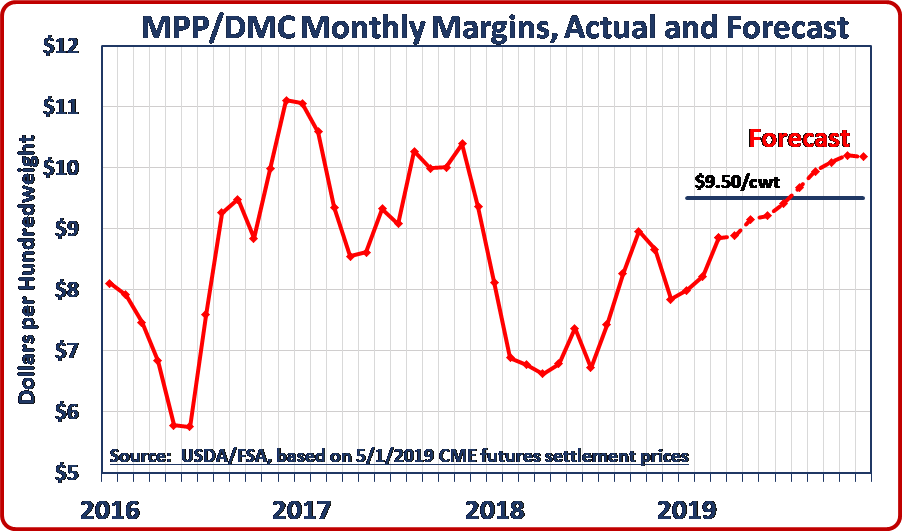Cooperative Members, Dairy Experts Testify in Agriculture Subcommittee’s First Hearing
May 13, 2019In its first hearing of the 116th Congress the House Agriculture Committee’s subcommittee on livestock and foreign agriculture focused on dairy’s improved safety net and the need for expanded exports, with farmers from NMPF cooperatives and industry leaders bringing national attention to industry concerns.
The hearing, called by Subcommittee Chairman Jim Costa (D-CA), spotlighted the low prices and trade concerns the sector faces while discussing the opportunities offered for producers through the new Dairy Margin Coverage program, calling solutions to dairy’s struggles one of the subcommittee’s highest priorities.
Testimony included:
- Minnesota dairy farmer Sadie Frericks, a member of Land O’Lakes, spoke of the importance of the new Dairy Margin Coverage program as a risk management tool as her family weathers economic challenges;
- California Dairies, Inc. President and CEO Andrei Mikhalevsky provided an overview of dairy’s trade issues, a rising concern as exports are crucial to increasing dairy demand;
- Pennsylvania dairy farmer Dave Smith, Executive Director of the Pennsylvania Dairymen’s Association, discussed additional challenges including the importance of milk consumption in schools and the need to combat mislabeled fake milks in the marketplace;
- New York dairy farmer Michael McMahon gave voice to the dairy industry’s unique workforce challenges, including the lack of a viable guest worker program that covers year-round workers;
- and Dr. Scott Brown, Director of Strategic Partnerships for the University of Missouri’s College of Agriculture, Food and Natural Resources, provided economic insight.
NMPF President and CEO Jim Mulhern thanked the participating farmers and industry leaders for bringing their crucial dairy perspectives to a national level and applauded the subcommittee for putting dairy first on its 2019 agenda, noting that the sector’s “challenges reverberate through the U.S. economy.” Mulhern also thanked lawmakers including Costa, subcommittee ranking member Rep. David Rouzer (R-NC), Agriculture Committee Chairman Rep. Collin Peterson (D-MN), and Congressman GT Thompson (R-PA) for their helpful opening and closing statements at the hearing.
NASS Numbers Show Third Straight Month of DMC Payouts
May 13, 2019
Fake-Dairy Drumbeat Continues as NMPF Calls Out Research, Balmer Cites Imposters
May 13, 2019NMPF and its allies are continuing their steady drumbeat against dairy imposters while President Donald Trump considers a replacement for departed FDA Commissioner Scott Gottlieb, working to ensure that the fake-dairy issue that gained widespread public attention in 2018 stays on the radar of the next agency chief.
In early May, the organization spoke against shoddy research undertook by the Plant Based Foods Association and the research firm it hired to do an incomplete and poorly executed analysis of comments in the FDA docket looking at nutritional confusion in plant-based versus dairy beverages that closed in January.
As has been the case throughout the current labeling debate, the fake-milk study mischaracterized what FDA is considering, trying to turn a serious discussion of consumer transparency and nutritional inferiority into a red-herring debate over whether consumers think almonds are a dairy product.
“None of the fake foods stealing dairy terms contain the same nutrition as the milk or dairy product they attempt to imitate,” said Jim Mulhern, president and CEO of the National Milk Producers Federation. “The vegan and animal rights activists who were encouraged by our opponents in this debate to flood the docket with comments understand that these fake products don’t contain milk. But that’s never been the issue. Research clearly shows that consumers don’t understand the nutritional differences between real, natural dairy products and the inferior, imitation products masquerading as milk.”
The rising tide of fake dairy was also called out by NMPF Executive Vice President Tom Balmer, who in his capacity as executive director of the American Butter Institute, spoke on the rise of misbranded products at that organization’s annual meeting in Chicago.
Balmer pointed that for generations, plant-based butter imitations have been marketed under a federal standard of identity as margarine or under the non-standardized term “vegetable oil spread.” Now, in the face of declining margarine and spread sales, companies are seeking to capitalize on butter’s resurgent popularity by misappropriating the term “butter” and applying it to products that clearly do not meet butter’s federal standard of identity.
This practice damages the integrity of food standards, Balmer said, and misleads consumers who may believe they’re buying an equivalent to butter when, in fact, no such quality standard is being met.
“Just because consumers are rejecting plant-based margarines and spreads, companies can’t turn around and violate federal law by slapping the term ‘butter’ on a product label and pretend it’s worthy of a dairy term,” Balmer said. “A falsely labeled product is a misbranded product, and misbranded products don’t belong on grocery shelves. The proliferation of these products is eroding the integrity of the marketplace, and the FDA needs to stop it before its own rules become meaningless.”
ABI filed a lengthy complaint to the FDA in September calling out imitators. NMPF filed a citizen petition with the agency in February, outlining a roadmap toward a constructive resolution of the problem of mislabeled, fake dairy products. That petition may be accessed here.
NMPF Pleased With NCIMS Results
May 13, 2019The 2019 National Conference on Interstate Milk Shipments meeting that ran from April 26-May 1 in St. Louis was an overall win for U.S. dairy producers, as NMPF staff, members and state and federal agencies successfully debated and secured modifications that help the industry.
The widely attended biennial conference included more than 400 federal, state and industry leaders. NMPF had submitted several proposals, three of which were considered “must-pass”:
- A proposal for streamlining the information required on a shipping statement for milk and milk products;
- A proposal on antibiotic testing that provides clarity on confirmation testing for antibiotic residues;
- And a proposal recognizing the importance of drug residue testing by making the ad-hoc committee on drug residue testing a permanent full standing committee.
Through collaboration with our members, the processing industry and our state and federal partners, all three proposals successfully made it through the complex NCIMS process.
NMPF also played a key role in advancing proposals from others that we felt warranted approval. NMPF helped craft modifications to several proposals that would have failed without the changes.
For example, an initiative to address how Grade “A” dairy plants that produce Grade “A” and non-Grade “A” products are to be inspected under the authorities of the Pasteurized Milk Ordinance (PMO) and the Food Safety Modernization Act (FSMA) was modified with NMPF’s help.
The changes resolved conflicts among the states and the FDA that, before the conference, were very much in conflict as to how inspections were to be conducted. The states, industry and FDA came to a solution that will maximize state and federal resources and create greater efficiencies while maintaining milk safety. FDA and an NCIMS committee will develop and implement a pilot to ensure these inspections are done sensibly.
The conference began on Friday, April 26th with committee discussions. About half of the 74 submitted proposals were assigned to a committee for an initial review. During the committee review a proposal can be passed, rejected or modified. A proposal that passes as submitted or modified then goes to a Council for further review. Councils then have the option to approve, reject or modify proposals prior to passing them on to the state delegates, where again the proposals could be accepted, rejected or modified.
NMPF will issue a special edition Regulatory Register which will cover conference proceedings and outcomes in more detail.
CWT-assisted Dairy Product Export Sales Greatly Exceed U.S. Milk Production Increase
May 13, 2019While U.S. milk production increased 103 million pounds in the first three months of 2019 according to the USDA, the Cooperatives Working Together (CWT) export assistance program for member cooperatives have captured sales contracts that will move overseas five times that amount in milk equivalent this year, proving again the self-help program’s worth to U.S. dairy farmers.
In April, CWT members secured 52 contracts to sell 1.2 million pounds of American-type and Swiss cheese, 1.2 million pounds of butter, 1.3 million pounds of whole milk powder, and 1.9 milk pounds of cream cheese. These products are going to customers in Asia, Central and South America, and the Middle East, and will be shipped April through October 2019.
These sales bring the total 2019 CWT-assisted dairy product exports to 26.6 million pounds of cheese, 4 million pounds of butter, 23.4 million pounds of whole milk powder, and 1.9 million pounds of cream cheese. These transactions will move the equivalent of 520.8 million pounds of milk on a milkfat basis overseas, all in 2019.
2019 will be pivotal for dairy farmers, with higher milk prices a necessity following the challenges of the past half-decade. Dairy farmers and dairy cooperatives now and in the years ahead will increasingly rely on a thriving export market for growth and viability. CWT provides a means to move domestic dairy products to overseas markets by helping to overcome certain disadvantages such as the domestic/global price gap and shipping costs.
The amounts of dairy products and related milk volumes reflect current contracts for delivery, not completed export volumes. CWT will pay export assistance to the bidders only when export and delivery of the product is verified by the submission of the required documentation.
All cooperatives and dairy farmers are encouraged to add their support to this important program. Membership forms are available here.
Farm Groups Unite to Demand Level Playing Field in Japan
May 13, 2019Expanded agricultural market access to Japan is vital for America’s struggling rural economy, and that access needs to be on par with what’s already enjoyed by U.S. competitors. That was the message delivered by NMPF, many of its members and dozens of other farm and food organizations among the nearly 90 signatories of a letter sent last month to the U.S. Trade Representative. The letter detailed the need for a swift and strong U.S.-Japan trade deal that addresses the needs of American farmers and food makers.
“The U.S. food and agriculture industry is increasingly disadvantaged by competing regional and bilateral agreements with Japan that have already been implemented, including the Comprehensive and Progressive Agreement for Trans-Pacific Partnership (CPTPP) and the European Union-Japan Economic Partnership Agreement (EU-Japan EPA),” the groups, which included the American Farm Bureau Federation, the International Dairy Foods Association, and other agricultural leaders said in their letter to USTR.
Japan recently decreased tariffs on agricultural imports from the European Union and CPTPP member countries, which, the group warned, is stealing markets once enjoyed by American exporters.
NMPF has worked with others in agriculture over the past two years for the launch of trade negotiations with Japan as other competitors have begun to enjoy the fruits of expanded market access not shared by the U.S. The administration finally took the necessary step of announcing talks late last year, formally starting negotiations last month. NMPF is focused on touting the urgent need for a deal with Japan that helps U.S. dairy exporters maintain and grow their competitiveness in this dairy-hungry market.
The United States exported $270 million in dairy goods to Japan in 2018, making it the fifth-largest buyer of U.S. products. A USDEC study earlier this year showed that America could double its share of the Japanese market over the next 10 years if given appropriate market access. Without positive action from trade officials, the USDEC study forecast that dairy exports to Japan will fall 20 percent over the next 5 years, as Europe, Australia, and New Zealand increase their dominance in the market, given the benefits their own trade treaties with Japan provide them.
Because of that risk, NMPF will continue to work with the Trump Administration and others in food and agriculture to drive towards robust results for dairy in the ongoing U.S.-Japan trade negotiations. A U.S. trade agreement with Japan is needed quickly, and it must include market access provisions at least equal to the terms of the CPTPP and the EU-Japan EPA, building on those precedents where possible, the letter urges.
With $277 Million at Stake for Dairy, USMCA Progresses
May 13, 2019The U.S.-Mexico-Canada Agreement (USMCA) cleared an important procedural step in recent weeks, moving it one step closer to possible ratification, as the U.S. International Trade Commission (ITC) released an economic impact study touting the pact’s financial benefits for the U.S. The 375-page ITC report found that, if fully implemented and enforced, USMCA would add more than $68 billion to the U.S. economy and 176,000 U.S. jobs by its sixth year. For dairy, ITC projected a positive impact of $277 million, with most gains coming from increased tariff-rate quota access to Canada.
USMCA’s importance for dairy extends well beyond the market access improvements with Canada that the ITC accounted for, as NMPF noted in our release welcoming the publication of the report. USMCA solidifies essential trading channels with Mexico – where the U.S. shipped $1.4 billion in dairy products last year – and tears down the controversial Class-7 milk pricing scheme, instituting new disciplines on Canadian dairy policies to keep their trade-distorting capacity in check. Moreover, the deal ushers in new rules on GIs and SPS issues to reduce the prospect of unjustified barriers to trade cropping up.
USTR touted those improvements in an agriculture-focused fact sheet released in early May that prominently featured dairy’s gains. The document’s heavy dairy focus illustrated the outsized benefits the agreement holds for it compared to other farm sectors, a result of NMPF’s strong investment in using USMCA as a vehicle for pursuing further upgrades to the existing NAFTA deal that’s boosted exports to Mexico.
“It’s important to keep the full picture in mind of what’s at stake when examining USMCA’s benefit to the economy,” said Jim Mulhern, president and CEO of National Milk Producers Federation. USDA recently reported that the U.S. lost more than seven dairy farms a day in 2018 due to poor economic conditions. NMPF is pushing back against this trend on multiple fronts. USMCA does that that by safeguarding our largest export market and instituting valuable new improvements to dairy trade in North America.
To continue to advocate for passing USMCA – and also the end of the Section 232 tariffs that curb U.S. cheese exports to Mexico – NMPF and its members participated in events taking place with members of Congress in the Midwest over last month’s Congressional recess. That included an event hosted by NMPF member Associated Milk Producers Inc. for Representative Jim Hagedorn (R-MN) from Minnesota and a roundtable with Rep. Ron Kind (D-WI) attended by Mulhern and Jeff Lyon, general manager of FarmFirst, an NMPF member cooperative.
Given the importance of NAFTA/USMCA to dairy and the urgent need to lift Mexican retaliatory tariffs levied in response to U.S. metal tariffs, NMPF will work closely with member co-ops and state dairy associations nationwide to build support for action by the government on both fronts.
FARM V4 Public Comment Period Summarized
May 13, 2019The FARM Animal Care Program welcomed public comments from all dairy industry stakeholders from the middle of February through the end of March. FARM received over 370 comments providing feedback on the draft standards that the FARM Technical Writing Group and National Milk Producers Federation Animal Health and Well-Being Committee have prepped for the fourth iteration of FARM Animal Care.
Of the total comments, 41.7% were received from cooperatives and processors, 25.5% came in directly from producers, and 15.6% were provided from veterinarians. Other industry stakeholders represented the remaining 17.2%.
The primary areas of the comments focused on: veterinarian involvement, pain management for disbudding procedures, antibiotic stewardship, and animal care training.
The Technical Writing Group and the NMPF Animal Health and Well-Being Committees is meeting to review comments and determine position statements related to the public submissions. Once those are summarized, staff will integrate that feedback into the draft standards that will then be presented to the National Milk Producers Federation Board of Directors for approval in June.
Version 4.0 of FARM Animal Care Program implementation will begin January 1.
Dairy Native Theresa Sweeney Joins NMPF Communications Staff
May 13, 2019
NMPF is pleased to announce that Theresa Sweeney has joined the staff as Communications Manager, working with NMPF Senior Vice President of Communications Alan Bjerga.
Sweeney arrives from the New York State Department of Agriculture and Markets, where she served as Special Assistant. In her role there, she worked on issues including rural development, forestry, and labor. She was a key contributor to several of the Department’s nonregulatory initiatives and the agency’s internal and external communications.
A native of California’s Central Valley, Theresa grew up on her family’s 300-cow dairy farm before moving to New York to study Government and Animal Science at Cornell University. “Theresa’s unique skill-set, dairy experience and educational background makes her a phenomenal fit at NMPF, and we’re all excited about what she will contribute to this organization,” Bjerga said.






